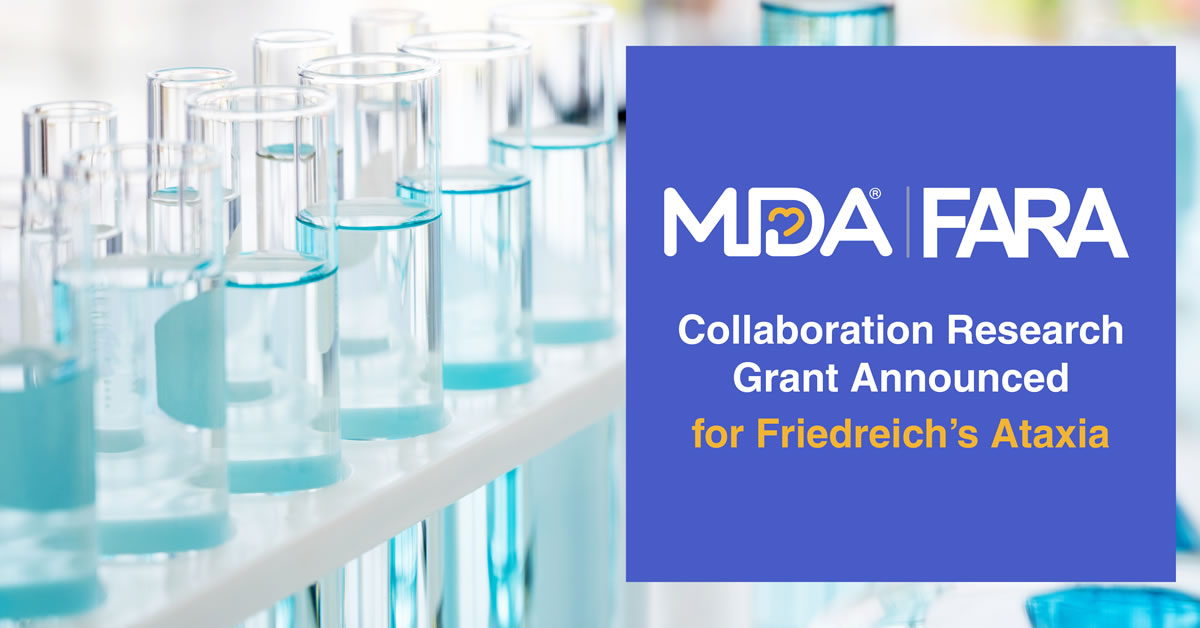About Us
Our mission is to empower people living with neuromuscular diseases to live longer, more independent lives.
Muscular Dystrophy Association and Friedreich’s Ataxia Research Alliance Announce Collaborative Research Grant Using Novel Gene Editing Technology to Address Root Cause of Friedreich’s Ataxia Disease
The grant will help diversify research methods to increase the likelihood of a successful treatment for the degenerative progressive disease that affects 1 in every 40,000 people worldwide and currently has limited treatment options.
NEW YORK, April 17, 2024 – The Muscular Dystrophy Association (MDA) and Friedreich’s Ataxia Research Alliance (FARA) announced today a collaborative grant for $300,000 awarded to Jonathan Watts, PhD, professor of RNA therapeutics; Erik Sontheimer, PhD, the Pillar Chair in Biomedical Research and professor of RNA therapeutics; Scot Wolfe, PhD, professor of molecular, cell & cancer biology; Wen Xue, PhD, associate professor of RNA therapeutics, a team of investigators at UMass Chan Medical School. This funding will further research into using novel genetic technologies to treat Friedreich’s ataxia (FA). The grant, Paired Prime Editors to treat Friedreich’s Ataxia, involves prime editing (PE), a next-generation CRISPR gene editing tool that can precisely target the removal of the GAA expansions in the frataxin (FXN) gene.

Gene editing for FA is an attractive therapeutic option because upon removal of the GAA repeats, the edited FXN gene will still be under the control of its natural regulator, thus alleviating concerns about the overexpression of frataxin.
“Our team of investigators is excited to bring multi-disciplinary expertise to the unique challenges of developing PE for FA. With an aim to demonstrate robust and specific GAA repeat removal from the FXN gene in human FA cells, this new and promising technology will require optimization on several fronts.” said Dr. Watts, UMass Chan Medical School. “I’m grateful the Muscular Dystrophy Association and Friedreich’s Ataxia Research Alliance have come together to support this research.”
The team will compare several PE approaches for their ability to remove the GAA repeats in FA cells with the goal to identify the optimal tool that can provide high efficiency of editing and reduced rate of off-target modifications to the genome. The investigators have also devised a system called split prime editing, in which two halves of the prime editing machinery are delivered as separate molecules. This approach allows them to rapidly test combinations of editing enzymes with desirable properties.
"We’re proud to co-fund this research with FARA. There has been a longstanding collaboration between our organizations for the benefit of the families we serve, including previous work together with FARA’s clinical research network. This research grant increases the likelihood of a breakthrough gene therapy for those who are living with Friedreich's ataxia," said Sharon Hesterlee, Ph.D., Chief Research Officer, MDA. "Early research in this area has shown significant promise, and we hope to accelerate the progress towards a treatment."
This treatment method being targeted – prime editing – aims to directly address the cause of the disease, which is the GAA expansion in the FXN gene. The grant from MDA and FARA will support the diversification of research opportunities and thereby increase the chance that one method will be found successful.
“This additional source of funding helps diversify therapeutic approaches to slow, stop, reverse, and ultimately cure Friedreich's ataxia,” said Jennifer Farmer, Chief Executive Officer of the Friedreich's Ataxia Research Alliance. “Our strategy at FARA has been to fill the pipeline with a range of targeted approaches, and we are grateful for the opportunity to work with Muscular Dystrophy Association and the investigators at UMass Chan Medical School to develop this promising area of research.”
“As someone with two sons living with Friedreich’s ataxia, I’m grateful to MDA and FARA for their collaborative efforts,” said Tom Henry, MDA family member. “This new grant is another reason to hope there will be a more targeted treatment for this disease and we are grateful to these investigators for prioritizing this novel research. This funding of research for a breakthrough in treatment reminds our family that we are not alone."
People with Friedreich’s ataxia (FA) experience issues with balance and coordination of movement that leads to life-altering loss of mobility. Other common symptoms can include fatigue, serious heart conditions, scoliosis, and diabetes. FA is inherited from a recessive gene from both parents. Symptoms usually appear in childhood or early teenage years and tend to worsen over time.
MDA has invested more than $20 million in FA research since its inception. MDA is proud to support this grant with funding from its Art and Soul benefit presented by Schnucks, an event dedicated to finding a cure for Friedreich’s ataxia.
About FARA:
The Friedreich’s Ataxia Research Alliance (FARA) is a national, 501(c)(3), nonprofit, organization dedicated to the pursuit of scientific research leading to treatments and a cure for Friedreich’s ataxia. FARA's mission is to marshal and focus the resources and relationships needed to cure FA by raising funds for research, promoting public awareness, and aligning scientists, patients, clinicians, government agencies, pharmaceutical companies and other organizations dedicated to curing FA and related diseases. To learn more visit curefa.org and follow FARA on Instagram, Facebook, X, LinkedIn and YouTube.
About Muscular Dystrophy Association
Muscular Dystrophy Association (MDA) is the #1 voluntary health organization in the United States for people living with muscular dystrophy, ALS, and related neuromuscular diseases. For over 70 years, MDA has led the way in accelerating research, advancing care, and advocating for the support of our families. MDA's mission is to empower the people we serve to live longer, more independent lives. To learn more visit mda.org and follow MDA on Instagram, Facebook, X, Threads, TikTok, LinkedIn, and YouTube.